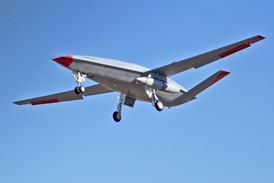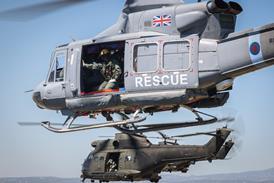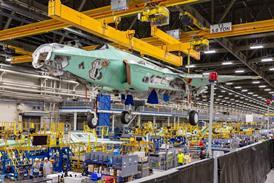Boeing C-17 strategic transports operated by the Royal Australian Air Force (RAAF) are providing a heavy lift capability to the nation’s research mission in Antarctica.
The aircraft operate about eight flights per season to Australia’s Wilkins Aerodrome during two windows, says Squadron Leader James Gotch. The aircraft fly heavy equipment to the continent from October to November, and fly it out again in February-March.
Operating from Hobart, Tasmania, each leg is four hours. The C-17 is not the only aircraft to serve Wilkins, which is operated by the Australian Antarctic Division. An Airbus A319 operated by Skytraders is also used, but it lacks the heavy lift capability of the C-17.
Cargo includes vehicles, generators, and other essentials to keep the base operational.
Wilkins is suitable for large aircraft operations because it is well inland and about 700m above sea level, which reduces the chance of the ice melting. This means that its 10,000ft runway, carved into glacial ice, does not shift, as runways located on ice closer to the coast tend to do.
“The ice there is 300ft thick,” says Gotch. “It doesn’t move.”
In preparation for a C-17 arrival, the staff at Wilkins have equipment to help corrugate the ice to provide friction. Even so, the runway is slippery. Boeing’s Runway Conditions Reading assigns a dry concrete runway with a rating of 23, while the ice runway at Wilkins rates a nine.
The airfield has a limited supply of fuel, so RAAF C-17s must carry enough for both legs of the mission. Typically a Wilkins-bound C-17 will depart with 230,000lbs of fuel and 60,0000lbs of cargo. If necessary, a Airbus Defence Space KC-30A (A330 MRTT) can be deployed to top up the C-17.
By far the biggest concern facing Gotch and his colleagues is weather. Meteorological data is scrutinised carefully before a mission. A major concern is snow falling on the aircraft while it is on the ice at Wilkins. Should ice form in sufficient quantities, it would make taking off too dangerous. In this case a rescue aircraft would need to fly in from Australia with deicing equipment.
This has not happened yet, but Gotch admits that during his one mission to Wilkins he was very attuned to weather conditions. He was alarmed to see a thin layer of ice forming on unusual parts of the aircraft - although the ice was well within Boeing’s tolerances.
Given the weather, C-17 crews prefer to keep their visits as short as possible. Gotch says that the longest a C-17 has stayed on the ice at Wilkins thus far was “five or six hours.”
Crew safety is also an issue. Even with chains on one’s boots it is easy to slip. On one mission an RAAF photographer fell and broke his wrist two minutes after disembarking from the aircraft.
Gotch adds that the C-17 can operate to Wilkins with no modifications, such as skies or skids, and that the type is easy to maneuver on the ice. “It’s designed for this.”
Source: FlightGlobal.com



















